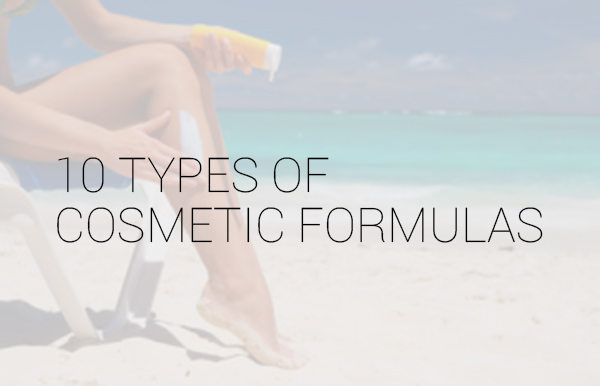Industry News, Cosmetics & Persnoal Cares
The 10 Different Types of Cosmetic Formulas You Must Know

Industry News, Cosmetics & Persnoal Cares

Link: The 10 Different Types of Cosmetic Formulas You Must Know | CHEMISTS CORNER
By: PERRY ROMANOWSKI
While there are literally thousands of different types of cosmetic products, there are actually only 10 different types of cosmetic formulas. Here is a brief overview of those types including what they are, how they’re made and when you might use them. As a formulating chemist, you should make it a point to learn to make each type (even if your company currently doesn’t make these particular products).
These are the simplest type of cosmetic formulas and are used for a wide range of products such as shampoos, body wash, hand cleansers, colognes, etc. They are homogeneous mixtures of soluble ingredients. To make them you simply fill your container with the main diluent (usually water) then mix the rest of the ingredients into it. Sometimes warming the system slightly will increase the speed at which you can make them.
The majority of cosmetics use raw materials that are not compatible so a cream or emulsion is used. Emulsions are pseudo stable mixtures of immiscible liquids dispersed in another liquid. They are used for products like hand moisturizers, make up, hair conditioners, sunscreens, etc. To create them you need three formula components including an oil phase, aqueous phase, and an emulsifier. The formulas are made by heating up the oil and water phases separately, mixing them together (along with the emulsifier) when they are hot, and cooling them down with thorough mixing. The result is a cream with tiny particles of dispersed in the diluent phase. See our article on emulsion HLB for more information on creating emulsions.
Creams are not always appropriate for some applications because they can be too heavy or greasy. In these cases, the lotion form is used. Lotions are essentially thin creams. They are used for facial moisturizers, leave-in hair conditioners, and moisturizing cleansers. Since these are emulsions, you make them the same way you would a cream. They are generally easier because you do not have to worry about the emulsion getting thick enough as it cools down.
Suspensions are another product form for delivering incompatible ingredients. Unlike creams, they are typically clear products with visible particles like gelatin beads or inorganic minerals (e.g titanium dioxide) suspended throughout. They are used for sunscreens, hand washes or shampoos. To create them you need to include a polymer or clay that gives the formula some internal suspending structure. Ingredients like carbomer or bentonite clays are useful.
These are super thick products used for things like hairdressing and medicated skin products. Usually, they are anhydrous (contain no water) and are sticky & greasy. Some common ingredients used to create pastes include petrolatum, lanolin, or dimethicone. Making them is a simple matter of heating up the raw materials and rapidly mixing them until they are dispersed.
Another product form that is often used for creating color cosmetics is the tablet. These are physically blended solids that are held together by being pressed into shape. You’ll need special equipment to create these products. They are also generally more expensive.
One of the most common types of product forms for color cosmetics is powders. Powders are also used for products like baby powder & foot powder. They are just mixtures of solid raw materials blended together into a fine powder. Some typical ingredients include talc, silicates, and starch. Special equipment is needed when making these products as the fine powder can be dangerous.
Another common form of cosmetic products is gels. These are thick products, typically clear, and have a property known as “shear thinning”. This means they stay thick until you apply a force which makes them thin and flowable. Anyone who has tried to get ketchup out of a bottle knows what we’re talking about. Gels are used for hair products, body washes, shaving products, and in toothpaste. They are made by using a gelling agent such as an acrylic polymer, a natural gum or a cellulosic thickener.
Sometimes you need to create a product that the consumer won’t necessarily want to touch, for example, lipstick or underarm deodorant. In these cases you’ll use a stick product form. Sticks are solid delivery forms that deliver active ingredients through a rubbing action. The way you create them is by using mostly materials that are solid at room temperature. The ingredients are heated until they melt, mixed, and poured into either a mold or the final container. When they cool, they take the shape of their packaging.
Aerosols are more of a packaging product form than a specific formulation type. You could actually create an aerosol out of almost any cosmetic formulation if you have the right can, propellant, and nozzle set-up. Aerosols are any cosmetic delivered from a pressurized can. They are composed of a concentrate and a propellant. You first make the formula as you would any other cosmetic, then fill it into the can. You seal the can and pressurize it using the appropriate propellant. Recent VOC (volatile organic compounds) regulations have reduced the use of aerosols in cosmetic products.
In the future, we’ll look at each of these product forms in depth. You can find out more information in Beginning Cosmetic Chemistry edition 3.
Copyright of this article by CHEMISTS CORNER. We are sharing and promoting the market innovation.
If you like this article, kindly to visit chemistscorner.com